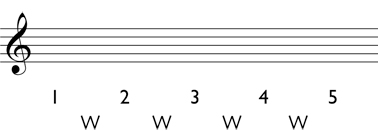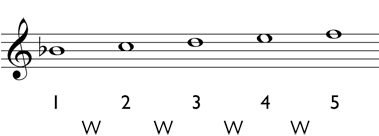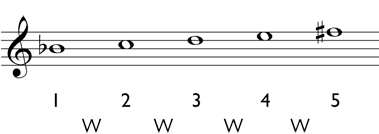Augmented Triads
The pitch spelling of the augmented triad is similar to the major triad, but the fifth scale degree is augmented or raised by a half step. Even though the pitches are similar, these two chords sound very different.
1. Write out the scale degrees under the staff. Like the other triads so far, only the numbers 1 through 5 are neede. We will continue to use B flat as our example.

2. Write the pattern of whole steps as they occur between each scale degree (W W W W).

3. Write in the first five pitches of the diatonic scale. Do not skip any pitches or repeat any pitches.

4. Check every whole step in the scale and write in the accidentals, when appropriate. If you need help remembering half steps and whole steps, visit that page in the section on melody.

Scale degree 1 to 2 is a whole step. A whole step above B flat is C, so no accidental is needed.
Scale degree 2 to 3 is a whole step. A whole step above C is D, so no accidental is needed.
Scale degree 3 to 4 is a whole step. A whole step above D is E, so no accidental is needed.
Scale degree 4 to 5 is a whole step. A whole step above E is F sharp, so the sharp accidental is needed.

The triad consist of scale degrees 1, 3, and 5 played at the same time. Therefore, the notes of a B flat augmented triad are B flat, D, and F sharp. When these notes are played one at a time, they are called a B flat augmented arpeggio.
